On the Road: Tanzania Humanitarian Mission, September 2009
September 1, 2009
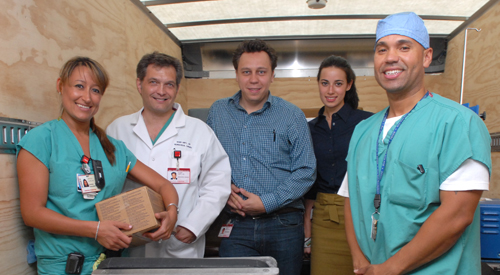
Dr. Hartl and his team are carrying out another exciting humanitarian mission to Africa. The program has the potential to greatly upgrade the way developing countries deliver health care. Working through Madaktari Africa, Dr. Hartl explains, “We are doing hands-on training of doctors in Eastern Africa, empowering them with a high level of expertise in neurosurgical procedures.”
Why focus on a high level of specialized techniques in an area desperate for the most basic levels of healthcare? Providing the highest level of surgical training to these eager, talented surgeons impacts every other level of care-- nursing, anesthesia, intensive care treatment, general ward care.
It all initially started in a small village in Tanzania. Dr. Hartl and his team trained doctors and delivered spinal surgery equipment that spared patients from paralysis. Today, patients are receiving treatment for neurological diseases such as hydrocephalus, meningocele, brain tumors and head trauma --without having to travel long trips involving great hardship to get important medical care. The current mission is at Bugando Hospital in northern Tanzania, a regional center which serves a population of 15 million people. The team’s goal is to replicate their previous success.
First Contact with Neurosurgery in Tanzania
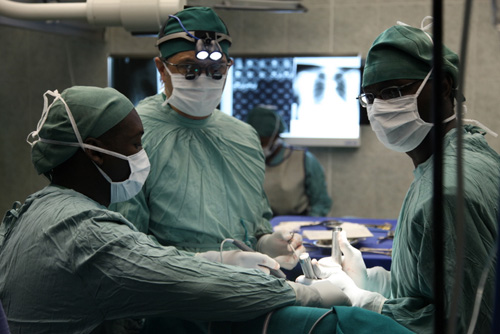
Our first day in Dar es Salaam was filled with excitement and a slow realization of the tremendous task that lies ahead of us. Our neurosurgical team consists of two neurosurgeons (from Weill Cornell and a resident from the Barrows Neurological Institute in Phoenix), a neurosurgical operating room nurse, a neurotrauma surgeon, a biomedical engineer and a student. We headed from the airport straight to Muhimbili Orthopedic Institute to see patients and evaluate CTs and MRI scans for upcoming surgeries in the next two days.
Our next morning began early with a trip to the neurosurgical hospital here in the capital of Tanzania, Dar es Salaam. We brought instrumentation for spinal surgery to an institution that is in dire need of surgical tools, and equipment to take care of victims of trauma and infection. We rounded on the children's floor and saw babies with the most extreme congenital deformities waiting for a surgery date. The skills and dedication of the three local neurosurgeons (the only ones in the country) are impressive. The sheer volume of patients and suffering, however, is overwhelming. Only one operating room is available for neurosurgical procedures per day. That afternoon we operated on two patients with spinal cord compression, one partially paralyzed and in critical condition. Both did well. A young man with a severe head injury from a motor vehicle accident was brought in by his family in their car - there are no public ambulances in Tanzania. Over the course of the day he deteriorated and had to be brought to the operating room for an emergent craniotomy. This experience vividly demonstrated the challenge of taking care of a case that we would otherwise consider "routine" and "straight-forward", in a country with limited resources and insufficient training. The evening during dinner was filled with personal reflections of the day and many discussions about what could and should be done ...
The plan for the rest of the week will be to spend one more day operating here in Dar es Salaam. On Sunday we will head to Mwanza, a large town in northern Tanzania. The regional hospital there currently does not have neurosurgical capabilities. The main objective of our mission is to assess the potential for the implementation of a neurosurgical training program at Bugando Hospital. Our mid term goal is to teach local surgeons to care safely and responsibly for basic urgent care and neurosurgical procedures. We are working with the Tanzanian Ministry of Health through Madaktari to eventually establish a formal neurosurgery training program. This is a long term goal that can only be achieved in collaboration with other US and European neurosurgeons and the local authorities.
A Warm Welcome at Bugando Hospital
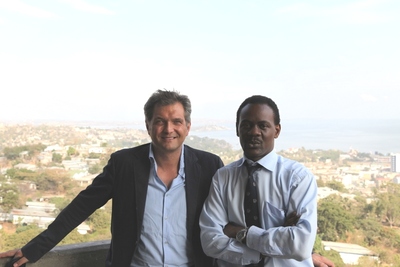 Dr. Kanumba is a young general surgeon who wants to specialize in neurosurgery. Individuals like him represent hope for this country.
Dr. Kanumba is a young general surgeon who wants to specialize in neurosurgery. Individuals like him represent hope for this country.
We arrived at Bugando last Sunday and were thankful for the cool breeze and wonderful views provided from the hilltops overlooking Lake Victoria. At the hospital we received a warm welcome the next morning by Dr. Majinge, the head of the hospital, and Dr. Mahalu, the chairman of surgery. We familiarized ourselves with the facility, located on top of a hill, the patients that they take care of, and their past exposure to neurosurgery. In summary, no neurosurgeon or neurologist has ever stepped foot inside this hospital, despite the fact that around 12-15 million people in the lakeside region of Tanzania rely on it as the referral and specialty hospital.
The only neurological operations performed are ventriculo-peritineal shunts and the repair of myelomeningoceles, congenital deformities of the brain and spine. These procedures are perfomed by general surgeons using the most basic tools. There are no neurosurgical instruments available. The number of little children presenting with these abnormalities is huge and they typically present at a very advanced stage.
One is faced with the task of conveying the most basic principles of neurological examination, diagnosis and treatment. Given the limited time available, this requires focusing our efforts on what seems to be the most pressing problem: deformites in children and the care of patients with traumatic brain and spinal cord injury. The treatment so far has been rudimentary and was based solely on medical and non-operative management. The population affected is typically young and and the current attitude appears to be that this is a non-treatable disease with a universally fatal outcome. The bad outcome observed in these patients seems to confirm this, but can hardly come as a surprise given the lack of treatment. We know that mortality from severe head injury has dropped from 50% to about 15% over the past decades in the Western hemisphere, mainly due to early and aggressive surgical and intensive care unit management. With education and training it should be possible to implement some basic and low-cost changes that will benefit these patients.
Scott, our pediatric neurosurgeon, is currently working with Dr. Emmanual Kanumba, a young general surgeon who hopes to become Bugando's first neurosurgeon one day. Together they have operated on a number of congenital brain and spine abnormalities. Lindsay, our operating room nurse from Cornell, scrubs in on all cases and has already become an essential resource to the OR nurses here.
We spent most of our first day unpacking material that we brought with us from New York. Most of this was generously donated by industry. Larry Foley from Life Instruments donated a set of spinal instruments. For several hours yesterday we went through the set explaining to the OR staff and surgeons the purpose of each instrument and how to handle them. Anspach donated a microsurgical drill which allows us to perform craniotomies and spinal procedures. Today one of the orthopedic surgeons will arrive from Dar es Salaam and bring with him a set of spinal instrumentation that Synthes has generally donated for my past two visits. Tomorrow we will perfom the first spinal instrumentation procedure in a patient with a severe spinal trauma. Finally we have been able to satisfy all the bureaucratic hurdles to clear a 20-foot container with neurosurgical equipment that we have sent with the help of AFYA in New York. The container is currently on a truck being maneuvered through the Tanzanian bush and should hopefully arrive within the next day or two.
Tae, our biomedical engineer, has been busy non-stop; fixing and repairing monitors, operating room tables and other vital equipment. His contribution will especially be crucial when it comes to installing the equipment that comes in the container.
Every day confronts us with new experiences. We learn about how people live and manage with very limited resources. Unfortunately, our time here will allow to us to only scratch the surface of some of the most pressing neurosurgical problems.
A Conversation with President Kikwete
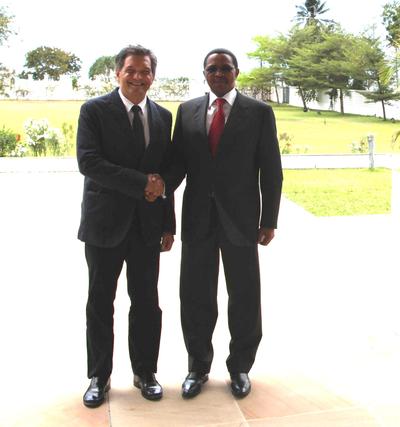
I met with President Kikwete, the leader of Tanzania, this morning in his private residence in Dar es Salaam. He was very interested in our work at Bugando Hospital and assured us of his government's support in the future. We had a very frank conversation about the neurosurgical problems that patients face in the rural parts of Tanzania; the lack of treatment for head and spinal trauma and the devastating impact of congenital deformities and hydrocephalus.
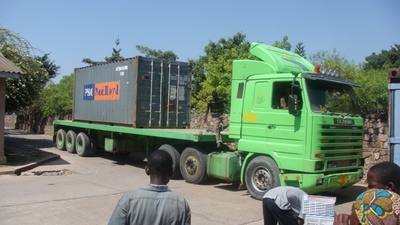 The container finally arrived!
The container finally arrived!
The Container Arrives
The container with lifesaving equipment finally arrived!
Tae, Scott and Lindsay unloaded the container last Friday with the help of our Tanzanian friends. Part of the equipment is being used already today, Monday, in the operating room. Unfortunately last Thursday and Friday the operating room had to close because of power failure in the city of Mwanza, causing a lack of running water in the hospital. Due to the fragile power supply in this part of the country this can happen anytime.
Scott was able to do one emergent case to relieve pressure in the brain of a small child with a brain tumor last friday despite the critical water situation.
In reviewing the last week some fundamental points become clear. What President Kikwete identifies as his top three priorities for the country - infrastructure, education and healthcare - also applies to our mission at a smaller scale. The problems with energy and water supply illustrate this. Also, the infrastructure to effectively and safely perform neurosurgery is lacking. The operating room is poorly kept and basic principles of sterility are not observed. This will require education of all health care personnel involved. As a positive, there is a tremendous amount of understanding and good-will from the individuals involved with Bugando. They want to make it work and bring this urgently needed service to the region.
The Work Continues
The water supply is back. Scott, Tae and Lindsay have been working non-stop in the hospital, interrupted only by a quick visit to Serengeti National Park over the weekend, which is only two hours away by car.
Scott’s summary of the last few days:"...we unloaded and sorted the container and then performed a VP shunt on a kid with medulloblastoma (doing much better now, but has severe ataxia due to cerebellar involvement). We were able to use the electric drill and the bipolar forceps that were on the container for that case. This was the first frontal shunt Emmanuel had ever done. Clinic filled the rest of the afternoon. On Monday, went through a neuro exam and again discussed the management of head injury during morning report. I encouraged them to raise the head of the bed for head trauma patients.Then we operated on 2 shunts and a myelomeningocele closure, followed again by a quick clinic. I talked to the radiologist who has agreed to do CT-myelogram on the two children I suspect have tethered cord or split-cord malformations..." (Backgound: MRI scans are not available and CT myelogram is a much less expensive and technically easy exam that can be done locally).Tae's account of the last few days:"...[T]his has been an incredibly productive visit. Last week I fixed 2 colposcopy units, a CIC central station and troubleshot 3 GE Aestiva ventilators, and 4 GE Dash 3000 monitors. On Friday we unloaded the medical equipment from the container and fixed the bipolar unit from the container (Scott was able to use the bipolar for surgery on Friday). Today I was able to move the OR table to the operating room and show them how to use it. I also fixed two other bipolar units and gave them to the OR..."Tae's account nicely illustrates that sending equipment alone is not good enough. On a mission like this you need someone there who knows how to install, troubleshoot and fix problems, and more importantly, to teach the local personnel how to use the expensive equipment.
Mission Reflections
Now that several weeks have passed, we have had time to digest and evaluate our Tanzania experience. After going back and forth weighing the deep impressions, the occasional frustrations and the generosity and warmth from locals that we experienced, what remains is a sense of hope for the future – hope that the Tanzanians succeed in solving some of their gigantic problems, and for us the hope that we may be part of this process.
Below are some of the comments from this year’s travellers. Some points are detailed and specific; however, for those readers interested in going one day, the information is invaluable: Scott (Neurosurgeon): …I was pretty frustrated at first. Both in Dar and in Bugando there is little sense of urgency for treatment for emergencies and no sense of neurosurgical urgency. … I was able to get a little of this across … I was able to talk the surgeon and the operating room into operating on a friday night for a child we saw in clinic with medulloblastoma. The ICU is obviously a problem. There is a lot of work to be done before we can take care of serious post-op craniotomies or do high-level head injury management. I think we were successful in 3 things with head trauma: raise the head of bed, check serum sodiums, stop steroids. That alone will probably save a couple of morbid or mortal outcomes per year. I helped Dr. E. put in a ventriculostomy catheter for a thalamic hemorrhage. This was the day I left. We managed it over e-mail and the patient did well. I am positive that the surgery department chair and hospital staff want us there. Temporary visits are nice but will do little to change the culture or make them self sufficient. My feeling is that all the parties interested in Tanzania neurosurgery should concentrate on one location (Bugando). If the support staff (or staff, nurses, radiologists, ICU registrar) know we aren't going away they will work with us. …I believe it is worth our time to be there, but again, concentrate on one place at a time. Lindsay Posner, RN (Cornell operating room nurse): It is apparent to anyone visiting Bugando that a neurosurgical program would greatly benefit the hospital. It is also apparent, however, that there are many steps that must be taken before this can be safely implemented. Education on proper sterile technique is a need that must be met before safely performing neurosurgery. Sterilizing instruments, scrubbing, draping, and prepping are a few of the issues that must be addressed. Further education regarding anesthesia and post-op care must also be addressed. Without the proper education regarding sterility and anesthesia, this program will not be able to move forward. In addition, there must be a constant presence of neurosurgeons, nurses, and anesthesiologists at Bugando to maintain the practice that we are teaching. A consistent rotation of surgeons would be key to the program's success. This would also increase interest and support from Bugando's staff. I would be interested in visiting Bugando again with the appropriate educational materials and with the support of other institutions. Harry Gebhard, trauma surgeon from Munich: Q: What do you think needs to be done first and foremost in order to safely perform neurosurgery at bugando?A: Recurrent visits of foreign surgeons are important and local data collection, a "surgeon's diary". Continuous education via electronic media (videos, powerpoints...) can be implemented. A proper department structure with landmarks like Grand Rounds, M&M conference... Q: Do you think they (local Bugando docs, the hospital in general, administration etc) are supportive and interested in moving forward?A: Physicians: It seemed to be a mixed picture. Some young individuals appeared very motivated, skillful and interested. Others didn't seem to be enthusiastic about changes and recommendations.Administration: seemed to acknowledge and welcome our mission, and appeared somewhat curious to see if this would actually initiate a whole series of recurrent visits.Hospital in general/staff: needs time and more visits/contact to get accustomed to our presence and to identify our role, gain trust. Q: Would you go again, do you think it was worthwhile?A: Over all, the mission fulfilled its goal - exploration. It was an eye opening experience to spend time with locals and individuals in the hospital to really understand the need, but also the pitfalls we are facing. It was crucial to discover the issues one is faced with in dealing with a third world country (shipment, electricity, device support, culture, every day life, setting up a proper team). This is very helpful for further missions of this kind and helps to focus on the actual work. …Future missions should, again, have defined goals. Planning/communication upfront is crucial for the actual success (within the team as well as with locals in Africa). Networking with other organizations on a regular basis is important. Tae Kim, Biomedical engineer: From a technical standpoint the main problem at Bugando Medical Center is power. They have two power generators but it takes 2 to 5 min to turn on when they lose power. They need big UPS (Uninterruptible power supply) on OR and ICU so they don’t lose any power on life support equipment. Other units in the hospital don’t have any life support equipment so no need to have UPS for all the units. … They get a lot of donated equipment but they don’t know how to use it or fix it. Also a lot of the equipment does not come with any accessories. I think before we send any equipment, we should find out what kind of equipment they have so we can send same or similar equipment. I found out they have 4 different ventilators plus 3 different ventilators we gave them. Now they have 7 different ventilators and it’s going to be hard for them to learn how use all of them. Also it is going to be hard for them to get accessories for all 7 ventilators. The OR needs a power outlet. Also they should have some 112 volt outlets. Some of the equipment cannot be converted into 220 volts so they have to use step down transformers but it can get in people's way and it's not safe to keep them on the floor because it can short circuit and start a fire. The specific equipment they need:1. UPS for OR and ICU2. ventilators3. bedside monitors4. Ultrasound5. warmer for babies6. step down transformer7. fetal monitors8. BP monitors It was worthwhile for me to go there and help them. Also I will go again if they need my help. This is Dr. Emmanuel S Kanumba’s response to our visit. He is a young surgeon who wants to specialize in neurosurgery and stay at Bugando: “…I would like to extend my greetings to you and the team that visited BUGANDO Hospital in MWANZA. I also like to inform you that we learned some quite important facts on our daily management of neurological diseases.This will have us focus on our patients with surgical neurological disease.I believe that in the near future we will be able to provide surgical neurological services in this part of the country.Thank you, and I appreciate beyond measures the donations of equipment to this hospital, the advice, teaching & all the assistance…. Boaz, the head nurse in the operating room also sent an e-mail expressing his enthusiasm for a continued involvement. In summary: The general environment is positive and supportive: hospital, staff, leadership. We have identified at least one surgeon who wants to dedicate himself to neurosurgery. Currently, simple neurosurgical cases can be performed. Basic imaging with CT is available. Many problems are very basic:
- Sterility and cleanliness in the OR
- Poorly structured surgery department: little teaching, few conferences, no dedicated neurosurgery service
- Limited possibilities for imaging because of availability and high costs
Action plan:
- All agree that the most important factor in improving neurosurgical care will be the repeated visit of neurosurgical groups from the US and Europe. These groups should come with an Attending and a resident (who should stay for at least 4 weeks). Groups should also include nurses, anesthesiologists and biomedical engineers.
- “Teaching modules” should be created or adopted that go through basic techniques: OR management, sterility, neurological exam, ICU care, how to read a CT scan, head trauma management etc. These should be made available on the Madaktari website and groups going over should teach them repeatedly.
- A neurosurgical drill is needed and cranial instruments. Other technical equipment should only be brought over if a biomedical engineer is involved and after the existing equipment and the needs have been clarified with the local neurosurgeon (Emmanuel) and the OR head nurse (Boaz).
- CT myelogram may be possible and should be taught to the radiologists
- All action needs to be coordinated in close contact with Madaktari and the Neurosurgery Department in Dar es Salaam, Dr. Kinasha.
Weill Cornell Medicine Center for Global Health
Center for Global Health
420 East 70th Street, 4th Floor, Suite LH-455
New York, NY 10021
Phone: (646) 962-8140
Fax: (646) 962-0285

